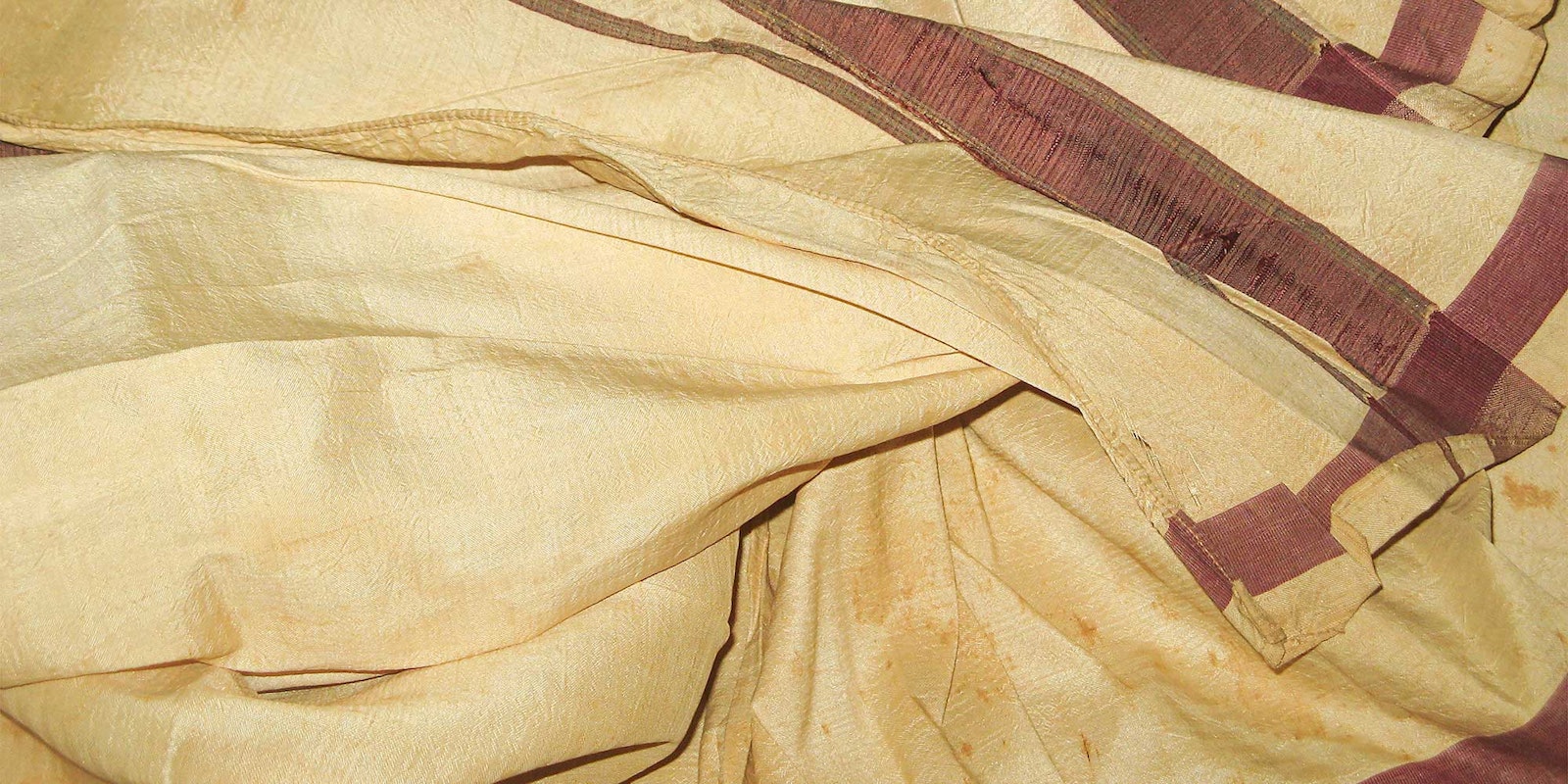Spin Off contributor and textile collector Chitra Balasubramaniam is based in New Delhi, but she frequently comes across textiles that send her off to learn more about makers throughout India. You can read about her quest to learn more about India’s sheep in Spin Off Winter 2024. Now, Chitra takes us on a journey to understand an antique dhoti and the silk used to spin and weave this ceremonial garment.
—Editors
I have been so engrossed in researching and collecting textiles made in India that I have missed researching my family’s heritage textiles. Apart from my grandmother’s saree and a few pieces made by my mother, the rest was literally consigned to history. This silk dhoti with a plain red border was buried deep in my dad’s, K S Balasubramaniam's, closet. A dhoti is a garment worn by men. It is a lower garment tied around the waist like a wraparound skirt.
A Hidden Treasure
My late mother’s rich collection of silk sarees is colorful, with beautiful motifs in gold, and so has an attractive charm. In comparison, this dhoti was drab looking and was overlooked for a long time. Finally, during one of our routine spring cleanings, I asked my dad whether it was his wedding dhoti. He shook his head and said, “No, that belonged to my grandfather!” My curiosity piqued, I asked him more about it.
In South India, worship of various gods called puja is done in most homes. The worshipper usually wears a silk dhoti that is woven specially for this purpose. The fabric worn like this is usually termed as kodi. It means brand new, pure, and not washed. It also means pavitra or holy. I am not sure how long this dhoti that my great-grandfather wore was used. When an apparel fabric comes in contact with water, it loses its purity. A worship or ritual garment is usually just worn brand new. The worshipper wears it for a very short time, removes it, folds it, and keeps it for later use. Most homes have several such dhotis to be worn by whoever does the worship. That was the origin of this dhoti, and I had no idea that my father had done such worship or ritual at home.
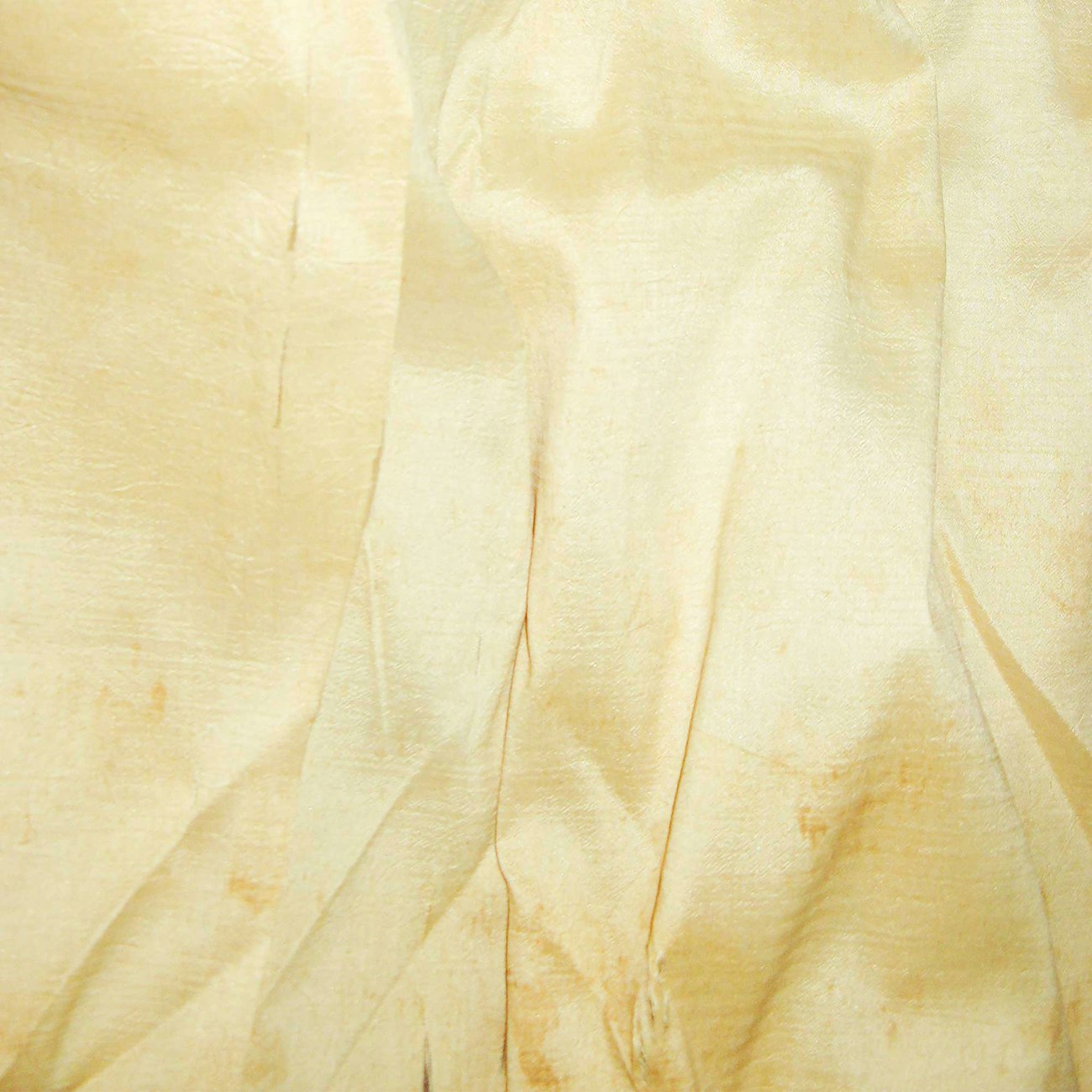 The silk dhoti that belonged to Chitra’s great-grandfather is a natural creamy off-white color.
The silk dhoti that belonged to Chitra’s great-grandfather is a natural creamy off-white color.
Dhoti Details
This silk dhoti is unbleached and unwashed. Silk softens with washing, but this dhoti is crisp in its pristine condition! It is the natural creamy off-white color of silk, called kora. It is a single dhoti, measuring 1.15 meters wide and 2 meters long (about 1.25 yards x 2.2 yards). There is a deep-red border at both ends. There is another set of borders running lengthwise along the warp.
Dhotis are usually available in two lengths: double dhoti and single dhoti. The double dhoti is usually 3.65 meters long (about 4 yards), while a single dhoti is approximately 2 meters long (about 2.2 yards) Given the fragile condition of this dhoti, it took a lot of my skills to measure it. My research finds that today, silk dhotis are only woven as double dhotis. The single one becomes very transparent. The silk yarn that is available now is very fine compared to what was used over one hundred years ago!
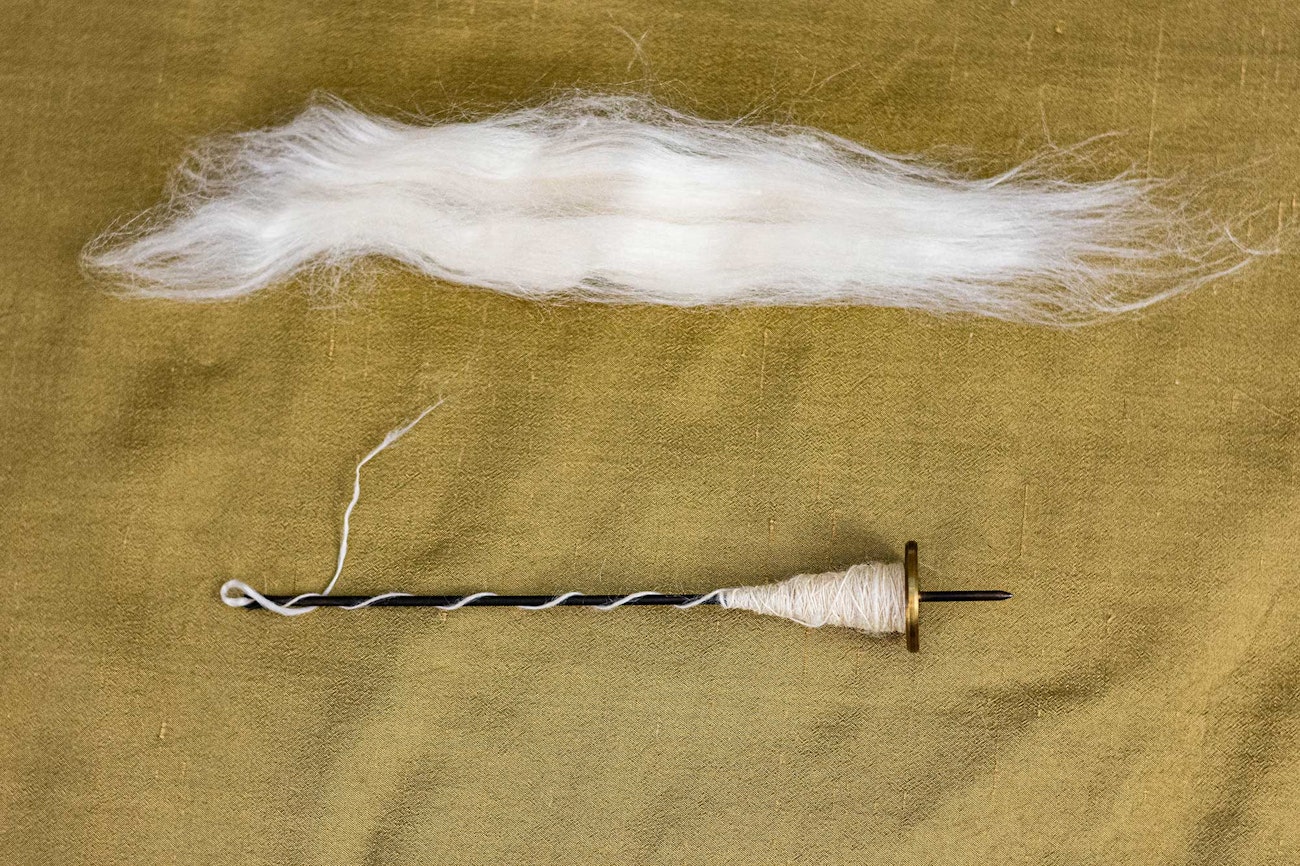 Silk spun on a takli spindle. Photo by Pamela K. Schultz
Silk spun on a takli spindle. Photo by Pamela K. Schultz
Spinning and Weaving Silk for a Dhoti
The silk in the dhoti is mulberry silk. I spoke to a Master Craftsman and weaver who has successfully revived a couple of forgotten weaves, Mr. Naseem Ahmed, or Naseem Bhai, as I address him. He said, “In olden days, everything was made by hand, hand reeled, handspun and handwoven. The method of extracting silk yarn was with the takli or taki. The end from the cocoon was reeled directly into yarn using the takli. Charkha came in much later.” There seem to have been several contraptions used for reeling silk during those days.
It is probably the reason the silk yarn is thick. Naseem further said, “It used to be called soot ka malmal which could be made cotton by cotton, silk by silk, or silk with cotton.” This dhoti is silk by silk—silk in the warp and weft. He added, “The reed per inch then was less. It was woven on what we call Ghetua loom. It is a predecessor to the jala and Jacquard looms. The weaving was done using extra warp threads. Apart from the usual warp for the fabric, the borders had extra warp thread. This could be dyed or could be in zari—gold threads.” This dhoti has naturally deep red-colored borders. It could be dyed using manjishta (madder) or lac.
Naseem explained the weaving technique: “The loom is a basic one—a pit loom, made using very fine bamboo sticks. The extra warp runs along with the main warp. The lifting plan was done by hand. There were no contraptions of any kind used. The weft works and the entire set of warp thread works together. The design is first drawn on paper. Then a sample is worked. The weaver carefully writes down how the warp and weft should flow for the design. Then the weaving starts.” The silk yarn reeled was starched using rice water or water leftover from making wheat bread.
The Ghetua is a simple loom, handmade using fine bamboo. The designs woven on it are simple, geometric, and not ornate. Designs drawn on paper can be replicated on the Ghetua by hand-manipulating the warp and weft threads. This was used to weave dhotis, bedspreads, and safa, or long, narrow turban cloths—cloths used to tie around the head. The technique was worked using extra warp threads. The yarn used at the ends of the dhoti was dyed using vegetable or natural colors. There is a slight grayish-greenish patterning along the warp, which is typical of dhotis in the south. The red color used on the border could be because it was meant for worship. Dhotis worn in weddings are usually made using zari or golden threads.
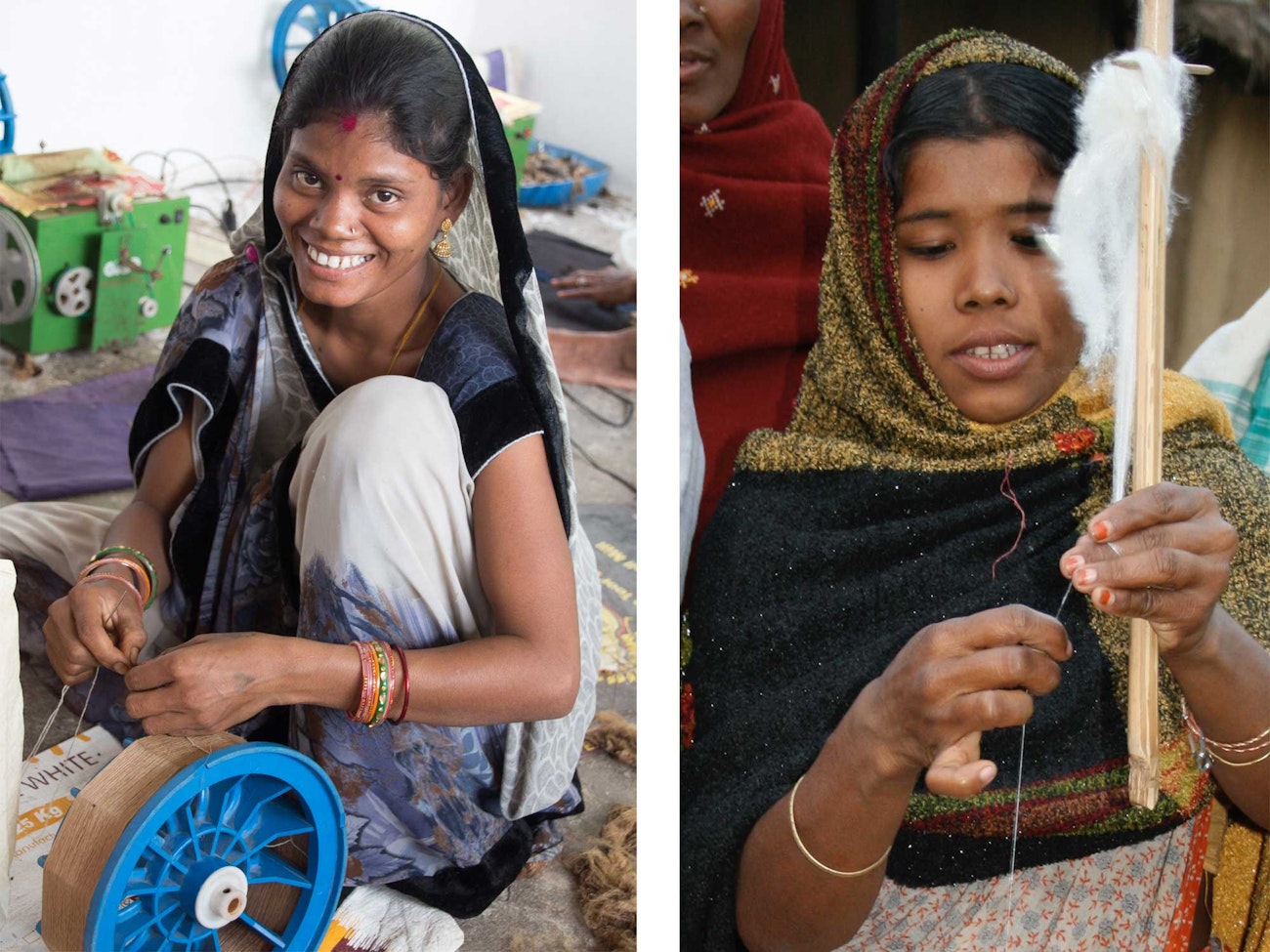 Left: Woman working on a modern reeling machine. Right: A young woman holds a distaff while spinning silk on a takli. (Takli not pictured.) Photos by Karen Selk from her book In Search of Wild Silk: Exploring a Village Industry in the Jungles of India
Left: Woman working on a modern reeling machine. Right: A young woman holds a distaff while spinning silk on a takli. (Takli not pictured.) Photos by Karen Selk from her book In Search of Wild Silk: Exploring a Village Industry in the Jungles of India
From Loom to Legacy
I am not sure where the silk was bought. My guess is that it may have been brought by traveling traders to my dad’s hometown Chittur in Palakkad, Kerala. In those days, most of the silk cloth came from Benares or Varanasi. Traders would come with silk wrapped in huge bundles. This was opened and shown in the homes.
Roughly calculating, the dhoti is more than 125 years old. It was used by my great-grandfather and then came to my dad after his passing on. Now just picking it up is scary, as it is fragile and tears. Silk, if kept folded for a long time, begins to tear at the folds. I will work on getting it restored very soon.
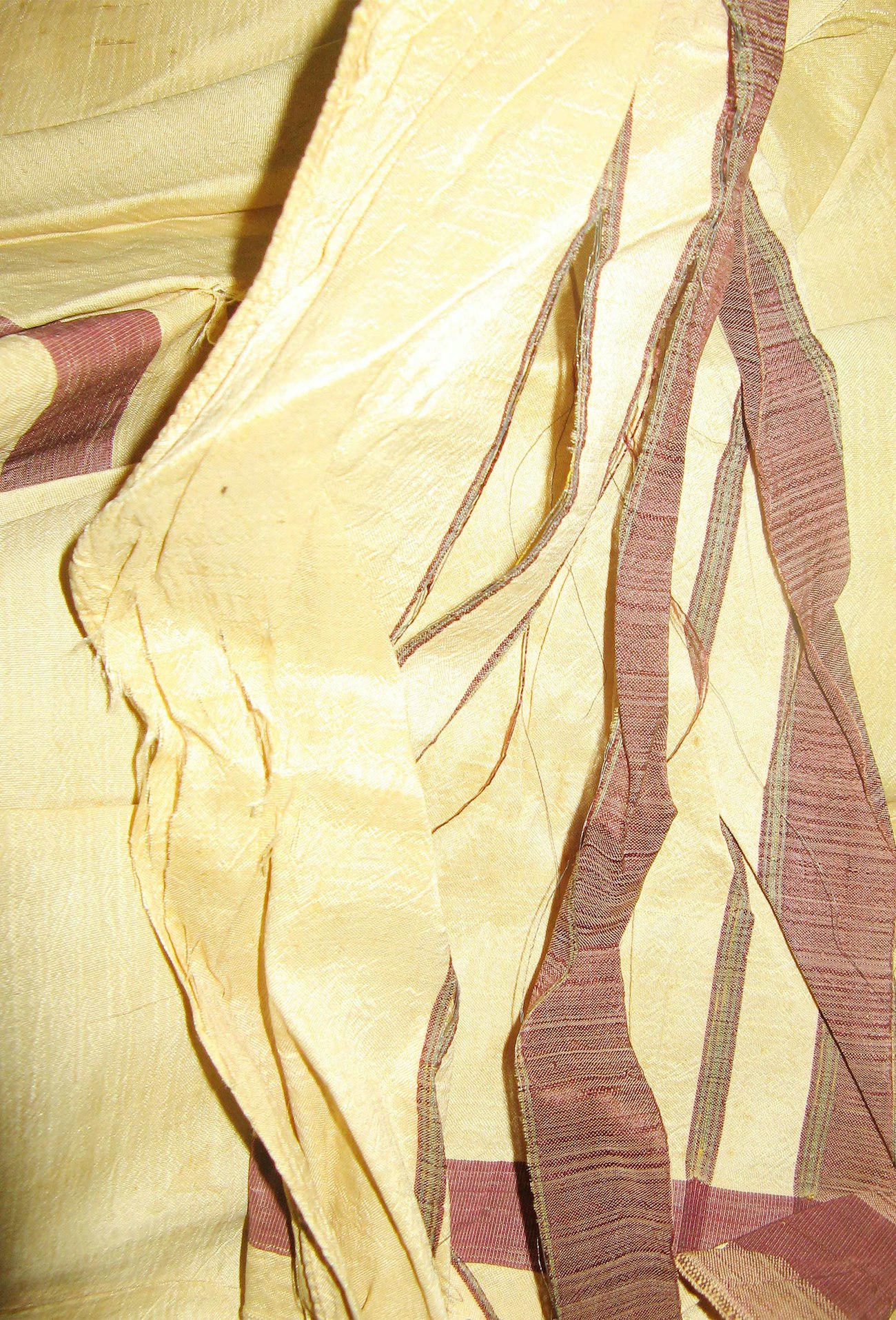 Silk becomes more delicate with age. A tear is visible in this image.
Silk becomes more delicate with age. A tear is visible in this image.
Resources
Also by Chitra Balasubramaniam:
More about spinning silk:
- Selk, Karen. In Search of Wild Silk: Exploring a Village Industry in the Jungles of India. Atglen, PA: Schiffer Publishing, 2022.
- “Your Guide to Silk with Karen Selk”
- About Silk with Karen Selk video mini-series
Learn more about natural dyeing with madder and lac in Spin Off Spring 2024.
Also, remember that if you are an active subscriber to Spin Off magazine, you have unlimited access to previous issues, including Spring 2024. See our help center for the step-by-step process on how to access them.
Chitra Balasubramaniam writes about, collects, and experiments with textiles, following her passion with writing on food, travel, and heritage. She dabbles with stock investment analysis and research. She also runs a small travel guide at www.visitors2delhi.com. Find her on Instagram as @visitors2delhi, @armchairtextilejourney, and on Twitter as @chitrabalasub.

